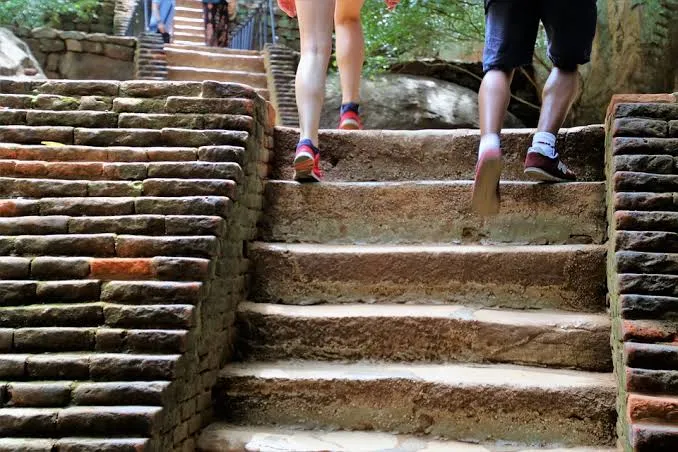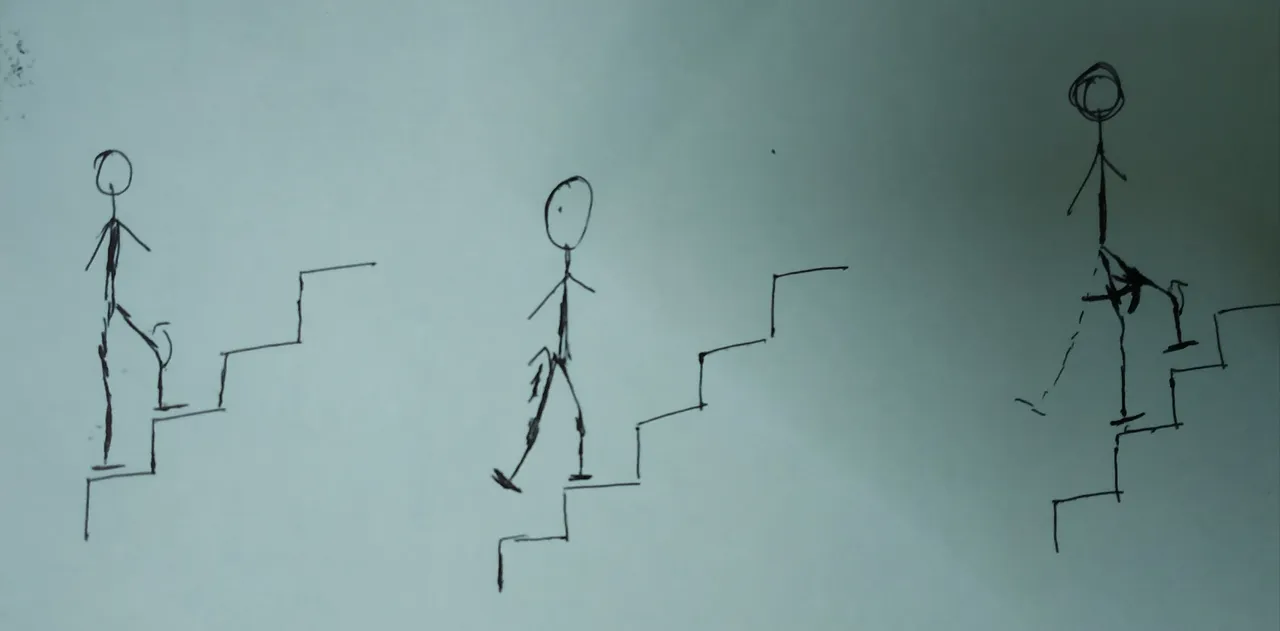StemQ Notice: The following is an answer to this question
Interesting question @irelandscape. Let's see if we can figure out the answer. I remember going to this trek as a child. During the 14 km of trek everybody walked step by step via ramp like path, but I took stairs climbing 1 or even 2 steps at a time. I not only reached early, but did not get exhausted. But was it because of the path that I took, or was I just a super enthusiastic kid? I don't know. Maybe, if we start by asking if energy demand by physics and energy spent by a biological machine are the same?

Image by pasja1000 | pixabay
How much energy is needed to climb the stairs?
If we go by physics of it, then a ramp and staircase of same angle and equal height must require same minimum amount of work, and in the end you have converted all your kinetic energy you generated to move up to potential energy = mgh. And lost all kinetic energy you generated to move forward to friction. But how much energy did you need in your muscle to generate that force? What physics tells you here is minimum energy that you would need to generate those forces. But machines generating that forces say from fuel or ATP (the fuel in case of muscles) may not be 100% efficient. Also it might be more efficient in climbing stairs than in climbing ramp. Net energy required to pull up two steps at a time could be different than that required while climbing one step at a time.
Measuring energy spent
One way to test how much energy in total is being spent, is to measure the amount of oxygen being consumed by body while working. Now sure, this is a proxy, it doesn't tell you the exact amount of energy being used in individual muscles to generate the required force. But you can use it as an average of all the muscles working together to complete the task. In 1972, Corlett et al., measured the oxygen consumed by the body in climbing stairs vs climbing a ramp. They found that stairs are always have less physiological price than a ramp. And, this has to do a lot with the way we move up a stair vs ramp. It has to do the way the torque is generated by muscles near knee joint, for example. Now one way to answer your question would be understand the kinematics of stair climbing.
The kinetics of climbing on stairs

Doodled by @scienceblocks

Recorded by @scienceblocks
When climbing stairs you need to generate the following forces -
Step 1 - you need to force to lift your first foot, and a torque to bend the knee (no, not in front of dragon queen).
Step 2 - after fixing your first foot on the ground you need to create a pull from your hips to lift of the second leg. You also need to generate torque to bend the knee, position it for the next stair. Next, you need to create a swing and move this leg forward.
The force needed to pull the lagging leg up and amount of muscle contraction to bend the knee, depends on height of the stair. The amount of forward swing required depends on distance you have to move further.
Hence in theory if your stair has a height of h and forward distance of x, then muscle contractions required for covering distance of twice the height, 2h and twice the length, 2x, should be twice, as well. So in a way, for n number of stairs the work done by muscles should be the same. That means even though the oxygen consumed by body would be twice for climbing 2 stairs at a time, at the end of the day you should consume equal amount of oxygen in both cases, because now you just walk n/2 steps. Right? Let's see!
In 2012, Halsey et al., used heart rate calibrated for oxygen consumption as measure of energy expenditure, during one step vs two step ascents. They found that single step method burned 8.5±0.1 kcal min−1, but double step ascent cost was 9.2±0.1 kcal min−1. Well, that's not really double. That's interesting. Given this we can make up equation for energy consumed during the ascent.
E = Ct, where C is consumption of calories per minute and t is minutes taken to climb n amount of stairs. Now, it is to be noted that time required to climb n amount of stairs, is less for two step strides, perhaps because people tend to take longer steps, trying to cover the double distance in similar amount of time for each step. This would mean that even though per minute energy consumption is more for double stride, single step stride will end up consuming more energy in a long run, for fixed amount of stairs.
But the thing that makes me yet more curious is, why doubling length and height of stair steps did not cause double of energy consumption, to begin with. So another answer to this question might lie in the way muscles work when taking smaller vs larger steps. As Halsey et al., 2012the authors explain there can be two reasons for this one being more muscle contraction frequency during single stride vs more muscle contraction during double stepping. Another reason can be the muscle fibres in use. The higher frequency of contraction during single step also require fast twitch muscle fibers, which consume more energy than power they deliver. In this regard, Teh and Aziz, 2005 found that, when they controlled for stepping frequency the heart rare and oxygen consumed was higher for single step strides. But by this method, the net energy consumed in a long run was only marginally higher for single steps than double steps. Nevertheless, at the end of the day it does look like single stepping is more energy expensive in a long run than double stepping on the same staircase.
In the end, I would like to say that this is the best explanation I could come up with from biological perspective. If there is a physical perspective it would be cool to hear. Maybe, we can try creating a simulation for one step vs two step climbing and figure out a way to test it.
References
StemQ Notice: This post was originally submitted on StemQ.io, a Q&A application for STEM subjects powered by the Steem blockchain.